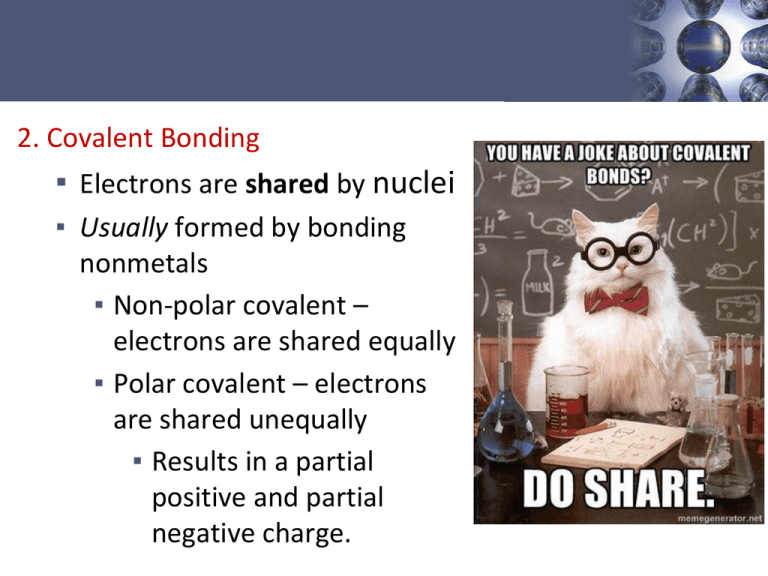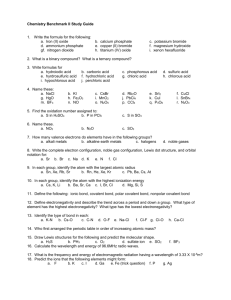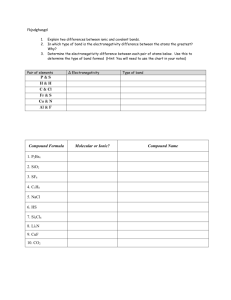
Section 8.1
Types of Chemical Bonds
2. Covalent Bonding
▪ Electrons are shared by nuclei
▪ Usually formed by bonding
nonmetals
▪ Non-polar covalent –
electrons are shared equally
▪ Polar covalent – electrons
are shared unequally
▪ Results in a partial
positive and partial
negative charge.
Section 8.1
Types of Chemical Bonds
2
Section 8.1
Types of Chemical Bonds
Ionic and Covalent bonding animation
http://www.youtube.com/watch?v=QqjcCvzWwww
Section 8.2
Electronegativity
▪ Hydrogen forms stable molecules where it shares two
electrons. (Duet rule)
Octet Rule
Almost all other elements form stable molecules when
surrounded by eight electrons.
F
+
7e-
F
F F
7e-
8e- 8e-
Lewis structure of F2
single covalent bond
lone pairs
F
F
lone pairs
single covalent bond
lone pairs
F F
lone pairs
5
Section 8.2
Electronegativity
▪ Single covalent bond: two atoms share one pair
of electrons.
H–H
▪ Example: All halogens form single covalent
bonds
Copyright © Cengage Learning. All rights reserved
All th
Section 8.2
Electronegativity
▪ A double covalent bond:
two atoms share two pairs
of electrons.
Example: O=O
▪ A triple covalent bond:
two atoms share three
pairs of electrons.
Example:
Section 8.2
Electronegativity
Bond Dissociation Energy
▪ Energy required to break a covalent bond
▪ Large dissociation energy means strong bond
▪ The more bonds located between 2 atoms, the
shorter the bond.
▪ The shorter the bond, the stronger the bond.
H–H Single bond
Weaker
O=O Double bond Stronger
N≡N Triple Bond
Strongest
Section 8.2
Bond Energies
Electronegativity
▪ To break bonds, energy must be added to the system
(endothermic, energy term carries a positive sign).
▪ To form bonds, energy is released (exothermic, energy
term carries a negative sign).
∆H = ΣD(bonds broken) – ΣD(bonds formed)
D represents the bond energy per mole of
bonds (always has a positive sign).
Copyright © Cengage Learning. All rights reserved
Section 8.2
Electronegativity
CONCEPT CHECK!
Predict ∆H for the following reaction:
Given the following information:
Bond Energy (kJ/mol)
C–H
413
C–N
305
C–C
347
891
[3(413) + 305 + 891] – [3(413) + 347 + 891] = –42 kJ
∆H = –42 kJ
Copyright © Cengage Learning. All rights reserved
Section 8.2
How to draw a Lewis structure
Electronegativity
1. Count the total number of valence electrons. For ions,
add 1 for each negative charge. Subtract 1 for each
positive charge.
2. Choose the central atom. The atom in front is often the
central. The central atom is usually the least
electronegative, or the atom with the highest valence.
3. Draw a skeletal structure – connect the atoms. No ring
around the rosy!
4. Arrange the remaining electrons to satisfy the octet
rule. If there are not enough electrons, form double or
triple bonds.
Section 8.2
Electronegativity
Example: Draw a Lewis structure for water.
Notice that a pair of
valence electrons are not
shared. They are ‘lone’
pairs.
Draw a Lewis structure for each of the following
molecules:
1. NH3
5. NH4+
2. HCN
6. CO2
3. CCl4
7. SO3
4. SO428. NO2-
Copyright © Cengage Learning. All rights reserved
Section 8.2
Electronegativity
End lesson 2








